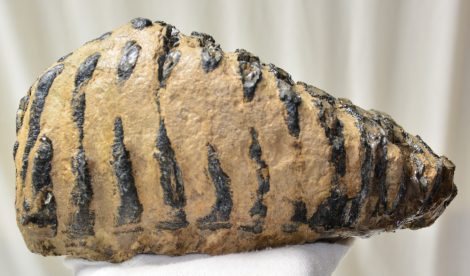- New arrivals
- Products in stock
- Mammuthus fossils [478]
- Megaloceros deer fossils [25]
- Bison Bos fossil [27]
- Rhinoceros fossil [31]
- Echinoderms sea urchin fossil [26]
- Plant wood fossils [38]
- Fish and shark fossils [53]
- Ammonites cephalopods [33]
- Mammalian vertebrates fossils [82]
- Dinosaurus fossil [52]
- Shells fossils [11]
- Gastropods fossils [28]
- Coral fossils [5]
- Trilobites & Crabs fossils [26]
- Minerals [26]
- Insect fossils [17]
- Other Fossils [16]
- Books, literature [10]
Mammuthus meridionalis tooth (2453 grams) Southern mammoth molar
Mammuthus meridionalis (southern mammoth) tooth. The mammoth fossil came to the surface during gravel mining in Pest County, Hungary. The dimensions of the tooth are approx.: length 218 mm, height 112 mm, width 97 mm. Weight approx.: 2456 grams + packaging. The surface of the tooth is preserved with a substance called Polyvinyl Butyral 30. A piece is missing from the front of the tooth.
"(Archidiscodon) Mammuthus meridionalis: Body dimensions: 3.5-3.8 m Geological age: Lower Pleistocene, 2,500,000-550,000 years ago Geographical distribution: Europe (Western and Southern Europe)
This species is also called the "southern elephant". It appears in the mammal fauna of Europe with the Pleistocene, so it can even be a symbol of the beginning of the Quaternary. The very first representative of real elephants. The appearance of this ancient elephant is reminiscent of the Indian elephant living today. Its back was almost straight, only slightly curved, while the African elephant living today slopes steeply from the front shoulder girdle. The tusks of the huge males bend slightly outward at the base, then horizontally and at the same time towards the center in a lute shape. The tusks of the females were much smaller, they did not bend upwards or twist inwards. Archidiscodon meridionalis was an inhabitant of savannahs, but also lived in sparse scrubby landscapes and forests; it did not inhabit the grassy steppes that can be clearly called steppes.









